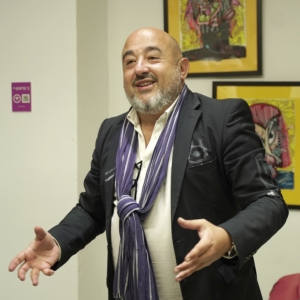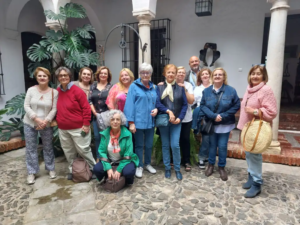Sumergiéndonos en la riqueza cultural del Museo de Artes y Costumbres Populares de Málaga con APAFIMA
Dentro de nuestro compromiso de Responsabilidad Social Corporativa, y en colaboración con el Museo de Artes y Costumbres Populares de Málaga, Fernando Carmona Torralba, experto en gestión cultural y socio fundador de Kripties, tuvo el privilegio de acompañar personalmente a un grupo de la Asociación de Pacientes de Fibromialgia de Málaga (APAFIMA) en una visita guiada a dicho museo. En esta ocasión disfrutamos de una jornada en uno de las colecciones más entrañables de la ciudad. En este artículo, exploraremos los aspectos más destacados de esta experiencia enriquecedora y nos sumergiremos en la fascinante colección etnográfica del museo.
Descubriendo la historia en la antigua posada de la Victoria:
El Museo de Artes y Costumbres Populares de Málaga, ubicado en lo que fue la posada de la Victoria, nos ofrece un apasionante viaje en el tiempo a través de sus diversas salas. Aquí, los participantes de APAFIMA tuvieron la oportunidad de sumergirse en la artesanía y la cultura popular de Málaga y su comarca, descubriendo la esencia de la vida cotidiana de tiempos pasados.
Las salas de la burguesía y los espacios recreados:
Uno de los puntos más destacados de la visita fue la exploración de las salas dedicadas a la burguesía. Los participantes se sintieron especialmente atraídos por el gabinete o despacho burgués, donde pudieron admirar los detalles de la vida privada y profesional de la época. Los magníficos ejemplos de atuendos burgueses expuestos también capturaron la atención, transportando a nuestros visitantes a una era de elegancia y distinción.
El encanto de los famosos barros malagueños y la taberna:
Otro aspecto destacado de la visita fue la oportunidad de apreciar la famosa colección de barros malagueños. Estas piezas de cerámica tradicional de la región son un testimonio vivo de la habilidad artesanal local y han dejado una huella indeleble en la identidad cultural de Málaga. Además, la taberna recreada en el museo ofreció un vistazo a la vida social y las tradiciones gastronómicas de antaño, invitando a los visitantes a imaginar el bullicio y la alegría que solían llenar estos espacios.
Una colección etnográfica que cautiva por su singularidad:
En conjunto, el Museo de Artes y Costumbres Populares de Málaga y su colección etnográfica nos sorprendieron con su belleza y singularidad. Cada objeto expuesto, desde los atuendos burgueses hasta los barros malagueños, nos permite comprender y apreciar la riqueza cultural de la región. La cuidadosa selección de elementos y la presentación meticulosa en las diferentes salas crean una experiencia inmersiva que transporta a los visitantes a través del tiempo y les permite conectarse con el pasado de Málaga de una manera única.
Noelia García, responsable del Museo de Artes y Costumbres Populares de Málaga, nos saludó durante la visita invitándonos a disfrutar plenamente de las instalaciones, dándonos la oportunidad de sumergirnos en la historia, la artesanía y la cultura popular de la región, explorando las salas de la burguesía, admirando los barros malagueños y experimentando la atmósfera de una taberna tradicional. La fascinante colección etnográfica del museo despertó el interés y la admiración de todos los presentes, dejando una impresión duradera de la riqueza cultural de Málaga y su legado histórico.
Diving into the cultural richness of the Museo de Artes y Costumbres Populares de Málaga with APAFIMA
As part of our commitment to Corporate Social Responsibility and in collaboration with the Málaga Museum of Popular Arts and Customs, Fernando Carmona Torralba, cultural management expert and founding partner of Kripties, had the privilege of personally guiding a group from the Association of Fibromyalgia Patients of Malaga (APAFIMA) on a tour of the museum. On this occasion, we enjoyed a day in one of the city’s most charming collections. In this article we will explore the highlights of this enriching experience and immerse ourselves in the museum’s fascinating ethnographic collection.
Discover history in the former Victoria Inn:
El Museo de Artes y Costumbres Populares de Málaga, ubicado en lo que fue la posada de la Victoria, nos The Museum of Popular Arts and Customs of Málaga, located in the former Victoria Inn, offers us an exciting journey back in time through its different rooms. Here, APAFIMA participants had the opportunity to immerse themselves in the crafts and popular culture of Malaga and its region, and to discover the essence of everyday life in times gone by.
The rooms of the bourgeoisie and the recreated spaces:
One of the highlights of the visit was the exploration of the rooms dedicated to the bourgeoisie. The participants were particularly drawn to the bourgeois cabinet or office, where they could admire the details of private and professional life at the time. The splendid examples of bourgeois dress on display also attracted attention, transporting our visitors back to a time of elegance and distinction.
The charm of the famous «barros malagueños» and the tavern:
Another highlight of the visit was the opportunity to see the famous collection of Barros Malagueños. These pieces of traditional pottery from the region are a living testimony to local craftsmanship and have left an indelible mark on Malaga’s cultural identity. In addition, the museum’s reconstructed tavern offers a glimpse of the social life and gastronomic traditions of the past, inviting visitors to imagine the hustle and bustle that once filled these rooms.
An ethnographic collection that is unique:
All in all, the Museum of Popular Art and Customs of Malaga and its ethnographic collection surprised us with its beauty and uniqueness. Each object on display, from folk costumes to Malaga pottery, allows us to understand and appreciate the cultural wealth of the region. The careful selection of elements and their meticulous presentation in the different rooms create an immersive experience that takes visitors back in time and allows them to connect with Malaga’s past in a unique way.
Noelia García, the director of the Museo de Artes y Costumbres Populares de Málaga (Malaga Museum of Popular Arts and Costume), welcomed us to the museum and invited us to take full advantage of its facilities, allowing us to immerse ourselves in the history, craftsmanship and popular culture of the region, exploring the rooms of the bourgeoisie, admiring the Barros Malagueños and experiencing the atmosphere of a traditional tavern. The museum’s fascinating ethnographic collection aroused the interest and admiration of everyone present, leaving a lasting impression of Malaga’s cultural wealth and historical heritage.




